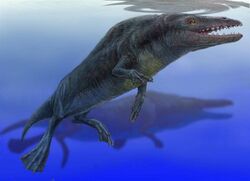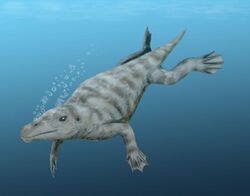Biology:Protocetidae
| Protocetidae | |
|---|---|

| |
| Maiacetus | |
| Scientific classification Error creating thumbnail: Unable to save thumbnail to destination
| |
| Domain: | Eukaryota |
| Kingdom: | Animalia |
| Phylum: | Chordata |
| Class: | Mammalia |
| Order: | Artiodactyla |
| Infraorder: | Cetacea |
| Informal group: | †Archaeoceti |
| Family: | †Protocetidae Stromer 1908 |
| Subfamilies | |
|
3, See text | |
Protocetidae, the protocetids, form a diverse and heterogeneous group of extinct cetaceans known from Asia, Europe, Africa, South America, and North America.
Description
There were many genera, and some of these are very well known (e.g., Rodhocetus). Known protocetids had large fore- and hindlimbs that could support the body on land, and it is likely that they lived amphibiously: in the sea and on land. It is unclear at present whether protocetids had flukes (the horizontal tail fin of modern cetaceans). However, what is clear is that they are adapted even further to an aquatic life-style. In Rodhocetus, for example, the sacrum – a bone that in land-mammals is a fusion of five vertebrae that connects the pelvis with the rest of the vertebral column – was divided into loose vertebrae. However, the pelvis retain a sacroiliac joint. Furthermore, the nasal openings are now halfway up the snout; a first step towards the telescoped condition in modern whales. Their supposed amphibious nature is supported by the discovery of a pregnant Maiacetus,[2] in which the fossilised fetus was positioned for a head-first delivery, suggesting that Maiacetus gave birth on land. The ungulate ancestry of these early whales is still underlined by characteristics like the presence of hooves at the ends of toes in Rodhocetus.
Taxonomy
The protocetid subfamilies were proposed by Gingerich et al. 2005. They placed Makaracetus in its own subfamily (Makaracetinae) based on its unique adaptations for feeding (including only two incisors in each premaxilla). They then erected two subfamilies for the rest of the protocetids based on their degree of aquatic adaptation:[3]
Protocetinae- Protocetines are Lutetian protocetids with generalized skulls retaining three incisors in the premaxilla and three molars in the maxilla. To the extent postcrania are known (primarily from Rodhocetus, and more recently Peregocetus),[4] they possess a pelvis similar to those in land-living mammals, a sacrum articulated to the ilia and innominates and large hindlimbs used for foot-powered propulsion.[3] Genera:
Georgiacetinae- Georgiacetines are Bartonian protocetids, considered transitional to the basilosaurids. Their skulls and dentition are similar to those of protocetines, but the pelvis in Georgiacetus and Aegicetus indicate a reduced sacroiliac joint, with no substantial articulation between backbone and innominates. Until recently, no hindlimb material was known for this subfamily, although the pelvic morphology seemed to hint at a tail-based rather than foot-based mode of aquatic locomotion. The discovery of Aegicetus supports this notion.[3][5] Genera:
Notes
- ↑ "Protocetidae". https://paleobiodb.org/classic/checkTaxonInfo?taxon_no=42934&is_real_user=1.
- ↑ Gingerich et al. 2009
- ↑ 3.0 3.1 3.2 Gingerich et al. 2005, Table 1, pp. 207–8
- ↑ Olivier L, Bianucci G, Salas-Gismondi R, Di Celma C, Steurbaut E, Urbina M & de Muizon C (2019). "An amphibious whale from the Middle Eocene of Peru reveals early South Pacific dispersal of quadrupedal cetaceans". Current Biology 29(8): p. 1352–1359.e3.
- ↑ Gingerich P.D., Antar M.S.M., Zalmout I.S. (2019). "Aegicetus gehennae, a new late Eocene protocetid (Cetacea, Archaeoceti) from Wadi Al Hitan, Egypt, and the transition to tail-powered swimming in whales". PLoS ONE 14(12):e0225391
References
- Gingerich, Philip D; ul-Haq, Munir; von Koenigswald, Wighart; Sanders, William J; Smith, B Holly; Zalmout, Iyad S (2009). "New Protocetid Whale from the Middle Eocene of Pakistan: Birth on Land, Precocial Development, and Sexual Dimorphism". PLOS ONE 4 (2): e4366. doi:10.1371/journal.pone.0004366. PMID 19194487. Bibcode: 2009PLoSO...4.4366G.
- Gingerich, Philip D.; Zalmout, Iyad S.; Ul-Haq, Munir; Bhatti, M. Akram (2005). "Makaracetus bidens, a new protocetid archaeocete (Mammalia, Cetacea) from the early middle Eocene of Balochistan (Pakistan)". Contributions from the Museum of Paleontology 31 (9): 197–210. OCLC 742723177. http://deepblue.lib.umich.edu/bitstream/handle/2027.42/41260/Vol%2031%20No%209%20Final.pdf. Retrieved 1 March 2013.
- Die Archaeoceti des ägyptischen Eozäns: Beiträge zur paläontologie und geologie Österreich-Ungarns und des Orients. W. Braumüller. 1908. OCLC 21174007. http://www.landesmuseum.at/pdf_frei_remote/BPalOeU_021_0106-0178.pdf. Retrieved 1 July 2013.
Wikidata ☰ Q2721468 entry
 |





